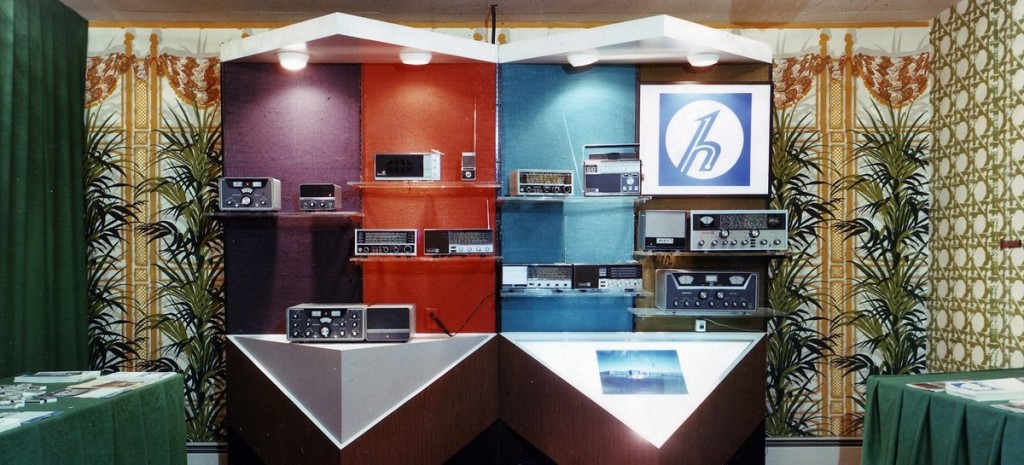Many thanks to SWLing Post reader, Bob, who writes:
A great photo for your blog, for no particular reason…
[The image above is a] part of a long blog post by Lenovo about CES history, but I did not see any attribution to Hallicrafters.
Here is the post:
http://blog.lenovo.com/en/blog/ces-history-technology-consumer-electronics-show/
Very, very cool! What I wouldn’t give to travel back to the CES shows of the 1970s and 80s.
According to the Levono blog, the 1970 CES was when the VCR made its debut. Amazing.
Thanks again, Bob.
I’m curious if any SWLing Post readers have attended the CES in past decades. I really wanted to attend CES in the 1990s, but since I was a university student half of that decade, I never had the funds (or justification) to do so!


Thomas & 13dka. Thanks for replying to my “computer cynical” comment. My interest in radio goes back to the 1960’s. After a long break from radio I returned very recently and it has been a real shock. I have updated in the sense that I purchased a CommRadio CR1A, the “semi sdr” that is used as a stand alone radio with no computer, that is all the updating that I intend doing.
Listening on the amateur bands I hear people missing out details and saying “my details on QRZ”. What is “QRZ” I wondered ? Quick search on the net and sure enough it is a web site. Very mixed feelings about this.
On VHF/UHF lots of new digital modes. Why ? The bands are nearly empty, repeaters sit unused. Morse test ended so Class B licence holders now allowed on HF. With little demand on bandwidth there seems to be no need for more modes.
Each to their own but I cannot find any interest in listening to so called broadcast band radio stations on a computer connected to a phone line.
Put it down to my age. I admit to building one valve regen receivers with 1.5 volt heaters and 90 volt on the anode many years ago, yes, it must be an age thing !!
Just a year before I got my Hallicrafters S-120A, there are two of those in the photo.
So close to the end of the company, yet I don’t think we knew what was going to happen. In 1971 Electronics Illustrated had a big DX contest, mostly for SWLers, with a massive list of prizes, all so interesting and new to an 11 year old just starting to read the hobby electronic magazines. But a number of the prizes were from Hallicrafters, some of their top end receivers.
I don’t remember seeing news at the time that the company had gone under, I don’t even remember noticing the ads disappearing. Yet at some point, we knew they’d gone.
Michael
Excellent photo, real radios and not a keyboard to be seen, great !!
Keyboards are your friend, they even let you type comments on great blogs! 🙂
True ! What I do not understand is this modern idea of listening to “radio?” on the internet. How can it be radio when no aerial is required and the sound comes down the phone line ? !!!!
It’s interesting, actually. I went to a radio convention once (can’t remember if it was the SWL Fest or a Ham Radio convention) and the presenter pointed out that there are more radios in more hands more than at any other time in history.
I’m sure I looked puzzled.
Then he pulled out his cell phone and said, “Hey..here’s a full-duplex transceiver right here in my hand.”
I understand what you mean though, Mick. I don’t feel like Internet radio is really “radio” radio. But a WiFi radio is, indeed, a small transceiver.
Instead of listening to a broadcaster’s main transmission antenna directly–a transmission antenna which is often fed content via a microwave link–you’re simply receiving from your much more local WiFi router’s transmission antenna which is fed content from the broadcaster via the Internet.
I feel like the thing Internet radio lacks is that sense of challenge: using skill to build an antenna, tweak a receiver and dig through the ether for faint, distant signals. That’s something hard to replicate. In terms of content, though, Internet radio is king. Almost an infinite variety of content out there from tens of thousands of outlets.
As I type this comment, I’m listening to Radio Australia via my shortwave radio, even though I could just as easily listen on a WiFi radio. That’s just how I’m wired.
-Thomas
That’s exactly the kind of technology commercial monitoring, coastal radio stations etc. had available for ages and what many amateurs could only dream of – remote receivers and antennas. You can make sure you receive some transmission you don’t want to miss, compare your station with others or if you’re a ham, check where your own transmission can be heard, for example when you’re dabbling with antennas and such.
BTW, even though the data is coming through a phone line, most of the receiver is still located in your home (your computer) and you can tune, change modes or do whatever you want with that remote receiver. That’s the beauty of web-based SDR, it gives you a personal network of antennas and locations and enables you to have great reception even when you’re sitting in a basement in the city with 9+60dB QRM. 🙂